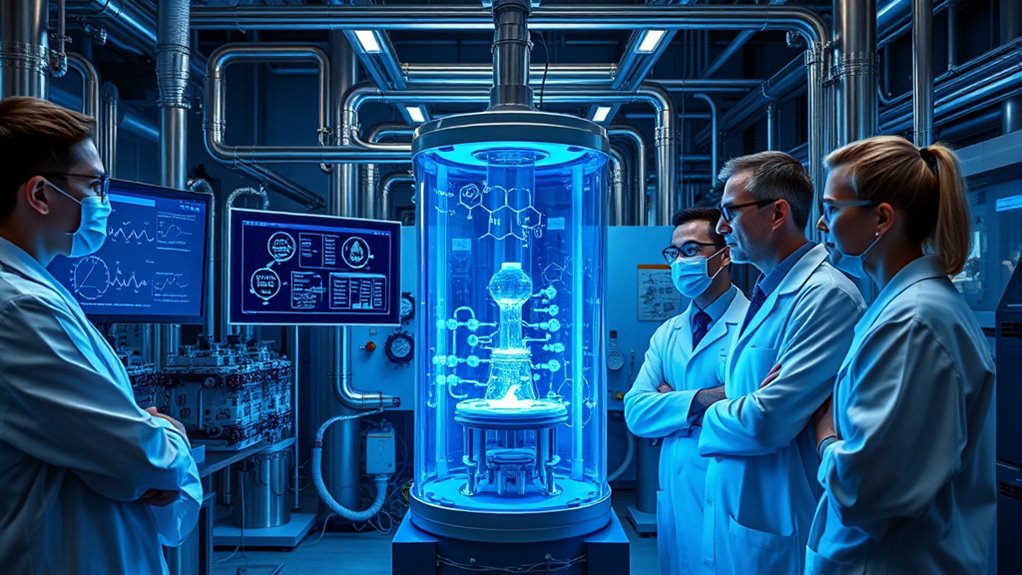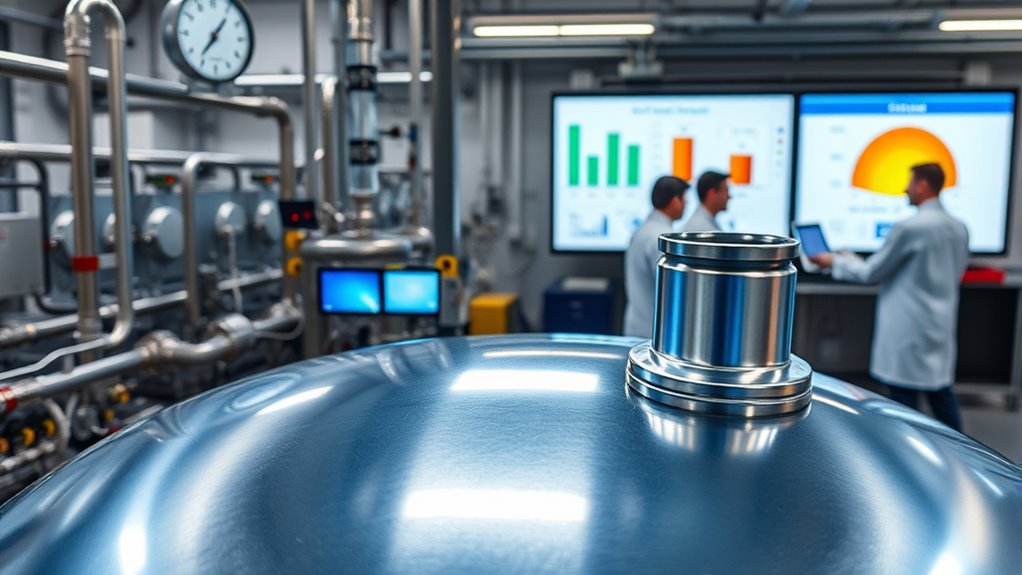Blue hydrogen is stirring debate because while it aims to produce cleaner fuel by capturing CO₂ during natural gas splitting, concerns remain about its true environmental benefits. Methane leaks and CCS system reliability threaten to offset its advantages. Experts argue it may slow renewable progress or be a necessary bridge, but its long-term viability is uncertain. To understand whether blue hydrogen really helps or hinders clean energy goals, keep exploring the issues involved.
Key Takeaways
- The environmental benefits of blue hydrogen are debated due to methane leaks and uncertainties in CCS effectiveness.
- Its role as a transitional fuel sparks discussions on whether it delays or accelerates renewable energy deployment.
- High costs and infrastructure challenges raise questions about blue hydrogen’s long-term sustainability.
- Concerns exist that reliance on blue hydrogen may divert resources from green hydrogen and renewable sources.
- Policymakers and scientists debate if blue hydrogen genuinely reduces overall emissions or shifts them elsewhere.

The debate over blue hydrogen‘s role in clean energy strategies has intensified as governments and industries seek sustainable solutions. At the heart of this discussion is whether blue hydrogen can genuinely reduce our carbon footprint or if it’s simply a transitional technology with limitations. When you consider its production, blue hydrogen involves splitting natural gas into hydrogen and carbon dioxide, with the latter captured and stored underground. This process aims to minimize greenhouse gas emissions, but questions about its technological feasibility persist. Can the current carbon capture and storage (CCS) systems reliably trap enough CO₂ to make blue hydrogen truly green? Some experts argue that although the technology has advanced, it still faces challenges like high costs, energy consumption, and potential leaks that threaten its overall effectiveness.
From your perspective, understanding the carbon footprint of blue hydrogen is critical. While it produces fewer emissions than traditional fossil fuels, it’s not entirely emission-free. The lifecycle emissions, including methane leaks during natural gas extraction and transportation, can significantly impact its environmental benefits. This raises questions about whether blue hydrogen genuinely advances your goal of reducing overall greenhouse gases or if it simply shifts emissions elsewhere. On the other hand, proponents highlight that blue hydrogen could serve as a bridge—helping industries transition away from coal and oil while renewable options scale up. They argue that, with improved CCS technologies, blue hydrogen could be produced with a much lower carbon footprint, making it a practical component of your clean energy mix.
Understanding blue hydrogen’s lifecycle emissions is crucial for assessing its true environmental impact and role in sustainable energy.
However, the technological feasibility of scaling blue hydrogen production remains a concern. The infrastructure needed for CCS is complex and costly, often requiring significant investment and regulatory support. You might wonder if current systems are robust enough to handle large-scale deployment without leaks or failures. Additionally, some critics point out that relying heavily on blue hydrogen could divert attention and resources from developing more sustainable solutions like wind, solar, and green hydrogen derived from electrolysis. They suggest that the focus should be on accelerating the adoption of renewable energy sources rather than investing heavily in technologies that still grapple with technical and economic hurdles. Furthermore, regulatory frameworks are essential to ensure the safe and effective deployment of CCS and blue hydrogen projects at scale.
In the end, your evaluation depends on weighing blue hydrogen’s potential to lower emissions against its current technological limitations. While it offers a promising pathway to reduce carbon footprints in the short term, questions about its long-term viability remain. The debate continues as scientists, policymakers, and industry leaders work to determine if blue hydrogen can truly meet the demands of a sustainable future or if it’s just a stepping stone to more permanent solutions.
Frequently Asked Questions
What Are the Long-Term Environmental Impacts of Blue Hydrogen?
You should consider that the long-term environmental impacts of blue hydrogen could include ecosystem disruption from methane leaks during production and transportation. Additionally, carbon leakage may occur if emissions aren’t fully captured, allowing greenhouse gases to escape into the atmosphere. These issues could undermine its clean energy benefits, making it essential to monitor and improve blue hydrogen production processes to minimize environmental harm over time.
How Does Blue Hydrogen Compare Cost-Wise to Green Hydrogen?
When comparing blue hydrogen to green hydrogen, you’ll find that cost analysis shows blue hydrogen currently has lower production costs, making it more market competitive. This is because blue hydrogen relies on natural gas with carbon capture, which is cheaper than the renewable energy required for green hydrogen. As a result, blue hydrogen remains a more economically viable option now, but green hydrogen’s costs are expected to decrease as technology advances.
Are There Any Safety Concerns With Blue Hydrogen Production?
You should know that safety concerns with blue hydrogen production mainly involve storage safety and leak prevention. Since blue hydrogen is produced from natural gas, there’s a risk of leaks that could lead to fire or explosions if not properly managed. Ensuring secure storage and leak prevention measures is vital to minimize these risks and keep blue hydrogen a safe energy option. Regular safety checks and advanced detection systems are essential.
What Policies Are Supporting Blue Hydrogen Development Worldwide?
You’ll find that policies supporting blue hydrogen development include various policy incentives like tax credits and grants, which encourage investment. International collaborations also play a role, fostering technology sharing and joint projects across countries. These strategies help scale blue hydrogen production, address climate goals, and promote clean energy transitions worldwide. Governments and organizations recognize blue hydrogen’s potential, making policy measures vital to accelerate its growth and guarantee sustainable, low-carbon energy solutions.
Can Blue Hydrogen Fully Replace Natural Gas in Industrial Use?
You might think blue hydrogen can fully replace natural gas in industry, but market viability remains uncertain. It’s unlikely you’ll see a complete switch soon because infrastructure challenges—like building new facilities and capturing carbon—are significant. While blue hydrogen offers a cleaner alternative, it currently can’t match natural gas’s widespread availability and cost-effectiveness. So, expect a gradual shift rather than an immediate full replacement.
Conclusion
As you navigate the debate over blue hydrogen, remember that Rome wasn’t built in a day. While it promises a cleaner energy future, it’s essential to weigh the benefits against potential environmental costs. Keep an open mind and stay informed, because the path to sustainable energy is a journey, not a sprint. In the end, every step counts toward building a greener world, one decision at a time.










